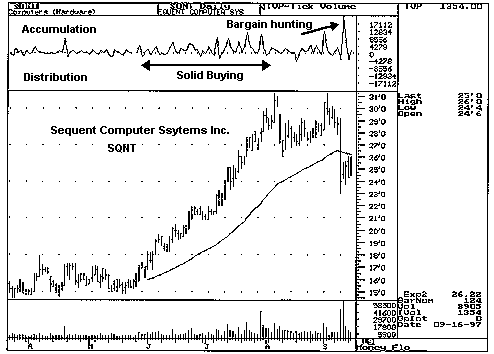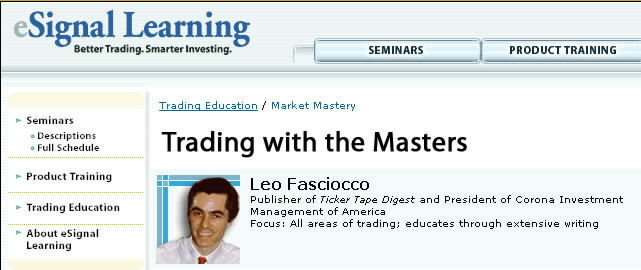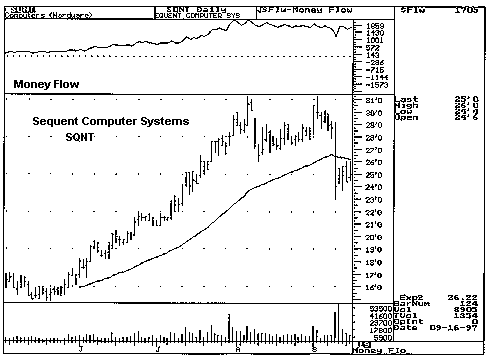
| Ticker Tape Digest -Home | Subscribe To TTD | Sample TTD Pro Report | Sample TTD Report Limited | Sample a TTD Stock Market Video Show | Translate to any Language |

Mr. Fasciocco has been a feature columnist on investing with eSignal for some 15 years. His articles appear at the eSignal website at www.esignal.com
He also collaborates with eSignal in their special feature section on "Trading with the Masters." That area of the eSignal website also showcases other top traders. eSignal did publish a book with over 30 articles by Mr. Fasciocco. The book is called: "Focus on Equities" - A compendium of money making ideas.
There's nothing like taking an initial stock position and seeing it start to work for you immediately.
I use several trading strategies covering various time frames and directions -- long and short.
In this article, I will cover one that an investor can use.
I call it: "The Big Earnings Surprise."
I am often amused when I hear TV commentators mention how a stock is up or down, and then they cite earnings that were a penny better or less than the consensus on Wall Street. To me, that is no news at all.
Instead, what I look for are companies that report earnings that are better by a significant amount from the highest estimate on The Street. I have found in my research that these stocks can often move higher in the earnings news and continue to trend higher for some time. In some cases, they can turn out to be leaders -- big winners -- in a new bull market.
Some big stock winners that reported a big earnings increase to kick off their advance were little-known J2 Global Communications Inc. (JCOM), which ran up from $3.75 in early 2002 and reached 29 by October of that year. It puts out Efaxes and provides other Internet services for communications.
Two other big winners were educational stocks. Corinthian Colleges Inc. (COCO) soared from 20 to 41 in 2002, and Apollo Group (APOL) advanced from 30 to 45.
How can an investor get in on these earnings-driven plays to improve their portfolio performance? Well, the key is to find stocks of companies reporting much stronger than expected earnings or that are reporting forecasts of great earnings. This can be done very easily by going to eSignal's Earnings announcement calendar. It can be found under the section called Research in the eSignal program.
Those stocks can be put into a file and checked for earnings during the day.
Also, one can go to bloomberg.com. This website has a feature section called "Earnings" which is helpful.
Ticker Tape Digest too will feature special earnings surprise stocks that are very bullish too us.
What you should be looking for are companies whose earnings surprise is significantly greater than what Wall Street analysts have been forecasting.
Also, it is ideal if the earnings are higher than a year ago.
A technical plus is if the stock is breaking out of a base on the news. However, this is not an essential. Make sure, too, when you're checking for earnings surprises, that any forecast made of future periods are also favorable. Don't get tricked into finding a favorable earnings report only to later discover that they downgraded earnings for future quarters.
Of course, it is ideal to get into these stocks as soon as possible after the earnings report is released. But, there are a few tricks to avoiding a few of the "lemons."
The stock must respond in a positive way to the earnings surprise news. If it does not, forget it.
There is something wrong.
On the other hand, If it moves up a few points or more, don't get scared -- get aggressive and go after it.
An ideal scenario of playing an earnings surprise stock would go like this:
1. Earnings are reported and they are well above Street estimates.
2. The stock responds by moving higher, sometimes gaping ahead in price.
3. You enter with at least a 50% position and then average up quickly.
4. The stock closes the day up several points. You set a protective stop.
5. Within the next few days, analysts raise their rating and the stock rises further.
6. Stock continues in an up trend and becomes a big winner in a bull market.
Sounds too easy to be true. Well, it can happen, especially with a potential bull market and a pick-up in the economy in the offing.
There are four seasonal periods when earnings reports pour in, and many of these opportunities will present themselves. They occur in April, July, October and January.
Of course, retailers, for instance, will report a month later than these four periods. That is because most retailers end their fiscal year on January 31.
Here is how you can prepare for these big earnings periods to spot these big earnings surprises. You can get a list of companies that will report earnings for the next week or two from the eSignal program's Research section.
Put these stocks into a file, making sure you put in the heading notation for news headlines.
Keep close watch when these companies report their earnings; be especially watchful prior to the NYSE opening in the morning and after the close.
Often times, you can get a play at the opening.
When you spot the earnings check to see if they topped the highest estimate on The Street by at least 10%.
Make sure the stock is liquid. Generally, NYSE stocks often react well to big earnings surprises. Next, quickly check to see if the stock is reacting in a positive way to the news. If so, initiate a position.
Depending on the stock market's trend and other factors, one can either take a quick profit or play the earnings surprise for more. Generally, if the stock market is in an up trend, and the group the stock belongs to is doing well, the odds favor staying with the stock for a bigger gain.
One of the reasons, many of these positive earnings surprises work well is that there is something "new" that is driving their business. That something new could be a better product or service, a new invention or just plain better management of operations. In any case, earnings are an important driver to push a stock higher. Spotting these big earnings surprise plays can put you on the track to some very good profits.
end
To Ticker Tape Digest - From Toby, A TTD Pro User
I'm very impressed with the overall quality of TTD's Day Trades (Given with the TTD Pro Report every day). The timing for EBAY was perfect, and there are a few others that may end up in the same category. I'm not sure, though, how a P&L study would work on your recommendations.
As you say in the report, you leave the 'Sell' price to be determined by each individual investor. Also, your commentary does not extend to stocks that had been bought some 2 to 5 days previous. So, for example, where would TTD have concluded that you closed the EBAY trade?
Could you possible add a new section to the Day Trade Report with your still-active stocks and daily revised Sell Stops? We do have our individually determined Sell points, but it would be instructive to see your ideas. Keep making money for us. Best regards, Toby
TTD's Reply: Toby, TTD's quick trades are for about three days. However, many trades can be closed within a day. For P&L purposes we will use three days as the max. Although, with EBAY, which gained some 40 points or more, it could have been more and made us look like geniuses.
Quick Trading as we like to call it should only be done with a small portion of one's portfolio. Also, stops must be followed strictly. Selling is a matter of personal preference. Some who want a small profit take it and are on their way. Others, though, may want to go for more. We like the long quick trades when the market is in an up trend. The percent winners is very high then.
--------------------
November 30 - To TTD, From Richard
Day trade on JDEC on the money! Webster definition as follows - swami - one that predicts events, person credited with extraordinary insight. Pls. tell BJ what with recent track record on day trades, pls. address you as "oh great swami". I'm sure she will do so. Rick G
TTD, Thanks. Let's just keep our eye on the percentages.
In tracking the "buying pressure" from Up Tick Volume, I am wondering if a stock that has moved up from a base, and with a big accumulation on the way up, doesn't mean that big buyers (esp. most institutions) have bought into it? And the stock might is at a potential risk.
In the example of SQNT there was indeed a tremendous up tick volume from $15 all the way up to $31. We can either say the stock has a solid accumulation pattern, or it might be "overbought".
Merril Lynch began covering SQNT with a short term and long term "accumulation", but the stock dropped like a rock to $25, almost a 15%. How can that be? Can it be indeed "overbought"? How can we prevent risk like this? Is it possible if we witness tremendous "up tick volume, during an extended period, the stock is overbought?
James
James, SQNT moved higher with good up tick volume confirmimg the advance. On a daily basis he stock could have been consered extended and liable to profit taking. On a weekly, or long-term basis, though the stock remains in a good up trend. As they say, nothing goes straight up.
The positive tick volume gave a good indication that all was well. A look at SQNT's chart below shows that even with the stock's fall, there was still good up tick volume indicating clear "bargain hunting." TTD likes to spot stocks in bases, with good earnings and strong up tick volume as key stocks to accumulate.
Your question also delt with institutional accumulation along the way. The obviously could have taken place. But, TTD would not worry about what institutions might be doing. We would instead focus on the tick volume and fit it in with the pattern of the stock's price and volume
Stephanie Harrison wrote:

In studying the Ticker Taper Analysis, I come across a research about "Money Flow". I think Money ey Flow is basically using the same idea as Ticker Tape's up/down tick volume, but it does provide a further accuracy.
Here is my understanding of "Money Flow" analysis, I don't know whether it is right or not, hopefully you can help me to look into it:
Money flow (starting from 0)
if (current tick's price > previous tick)
money@flow=money_flow + (tick-vol * price)
if (current tick's price < previous tick)
money_flow=moneylflow - (tick-vol * price)
if (current tick's price=previous tick)
money-flow no change.
Then drawing the Money flow chart, we can identify whether the money is flowing or out of the issue.
I think "Money Flow" considers not only up/down tick volume,
but it also takes into account the "price difference" to accurately measuer the exact money weight.
Am I right? Is it possible to have computer to do this? If so, can it give a better indication?
TTD's Answer:
Money flow is a cummulative of daily up vs. down tick volume. TTD tracks money flow. However, we have found it lags in giving an important perception of what is going on. Sometimes one day or two days of up tick volume is the key. When this happens money flow does not show it clearly. It lags. We have also found that on balance volume is usually worthless. It was developed before computers and adds all the volume for the day as up tick volume if the price closes higher. That means nothing. It does not take into account the intraday action.

I have 500 shares of an oil company stock that was purchased for my husband and I as a wedding gift from my parents in the early 1980's. I have since that time heard that the company went bankrupt, and my stock is now no good, but could you tell me how I can find out for sure? I really have never had anything to do with the stock market before and I don't have a clue as to how to go about finding out if these
certificates are any good or not. Any help would be appreciated.
TTD's Answer
There are three suggestions to find out about your company.
Copyright Ticker Tape Digest